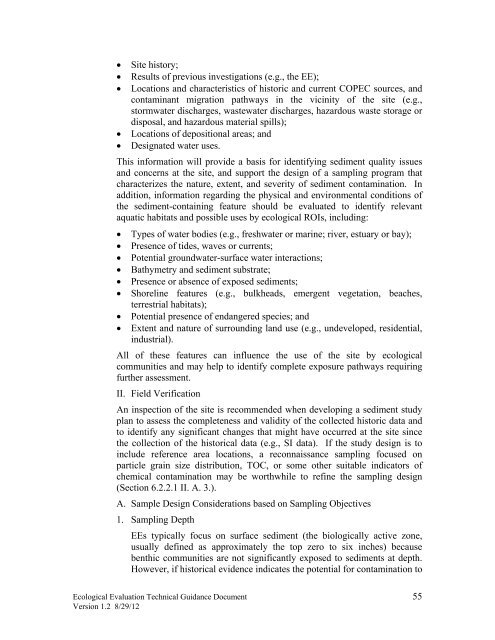Ecological Evaluation Technical Guidance - State of New Jersey
Ecological Evaluation Technical Guidance - State of New Jersey
Ecological Evaluation Technical Guidance - State of New Jersey
- No tags were found...
Create successful ePaper yourself
Turn your PDF publications into a flip-book with our unique Google optimized e-Paper software.
Site history;Results <strong>of</strong> previous investigations (e.g., the EE);Locations and characteristics <strong>of</strong> historic and current COPEC sources, andcontaminant migration pathways in the vicinity <strong>of</strong> the site (e.g.,stormwater discharges, wastewater discharges, hazardous waste storage ordisposal, and hazardous material spills);Locations <strong>of</strong> depositional areas; andDesignated water uses.This information will provide a basis for identifying sediment quality issuesand concerns at the site, and support the design <strong>of</strong> a sampling program thatcharacterizes the nature, extent, and severity <strong>of</strong> sediment contamination. Inaddition, information regarding the physical and environmental conditions <strong>of</strong>the sediment-containing feature should be evaluated to identify relevantaquatic habitats and possible uses by ecological ROIs, including:Types <strong>of</strong> water bodies (e.g., freshwater or marine; river, estuary or bay);Presence <strong>of</strong> tides, waves or currents;Potential groundwater-surface water interactions;Bathymetry and sediment substrate;Presence or absence <strong>of</strong> exposed sediments;Shoreline features (e.g., bulkheads, emergent vegetation, beaches,terrestrial habitats);Potential presence <strong>of</strong> endangered species; andExtent and nature <strong>of</strong> surrounding land use (e.g., undeveloped, residential,industrial).All <strong>of</strong> these features can influence the use <strong>of</strong> the site by ecologicalcommunities and may help to identify complete exposure pathways requiringfurther assessment.II. Field VerificationAn inspection <strong>of</strong> the site is recommended when developing a sediment studyplan to assess the completeness and validity <strong>of</strong> the collected historic data andto identify any significant changes that might have occurred at the site sincethe collection <strong>of</strong> the historical data (e.g., SI data). If the study design is toinclude reference area locations, a reconnaissance sampling focused onparticle grain size distribution, TOC, or some other suitable indicators <strong>of</strong>chemical contamination may be worthwhile to refine the sampling design(Section 6.2.2.1 II. A. 3.).A. Sample Design Considerations based on Sampling Objectives1. Sampling DepthEEs typically focus on surface sediment (the biologically active zone,usually defined as approximately the top zero to six inches) becausebenthic communities are not significantly exposed to sediments at depth.However, if historical evidence indicates the potential for contamination to<strong>Ecological</strong> <strong>Evaluation</strong> <strong>Technical</strong> <strong>Guidance</strong> Document 55Version 1.2 8/29/12
















